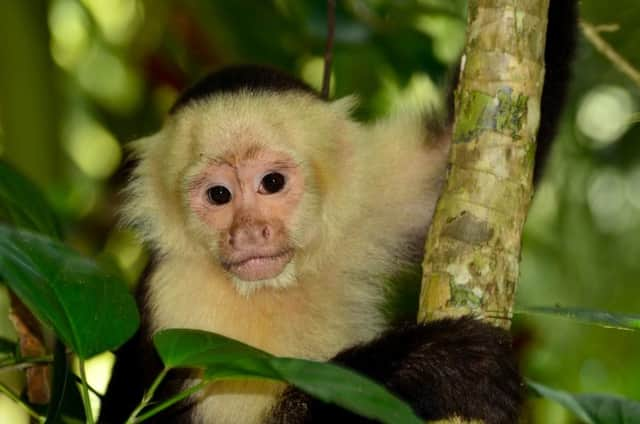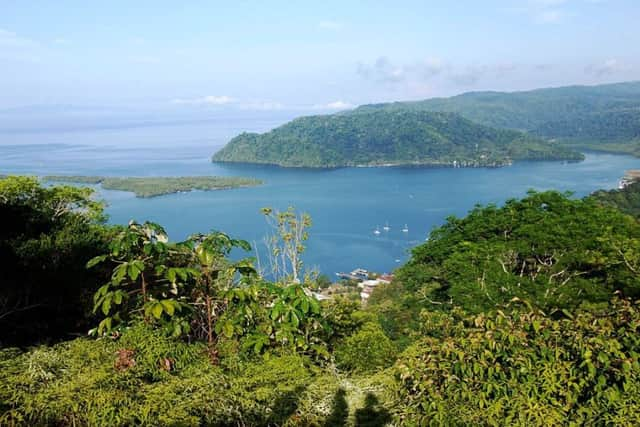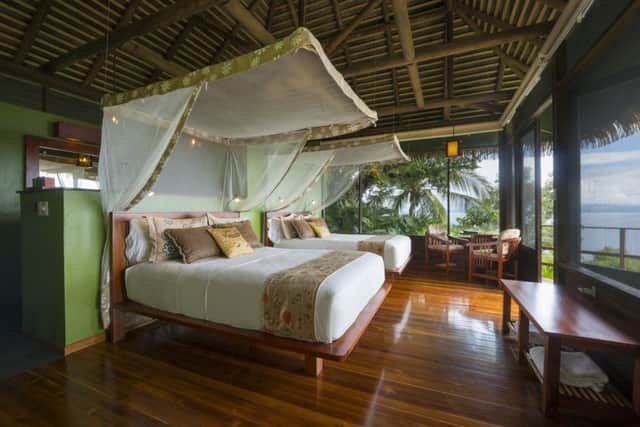Travel: Costa Rica


Rafting on the Pacuare River, which National Geographic lists as one of the world’s top ten most scenic waterways, to reach Pacuare Lodge is one of the many attractions of this eco-resort situated in the middle of the Central American country.
Surrounded by acres of rainforest and with the mighty Pacuare roaring constantly in the background, the resort pulls off the neat trick of sticking rigidly to its ecological ethos while at the same time providing unabashed luxury for guests.
Advertisement
Hide AdThe lodges are magnificent: spacious, well-appointed and private, and endearingly lo-tech. They have no plug points, and just one electric light – in the bathroom – that won’t work after 10pm. But there are plenty of candles – lit by staff when you’re at dinner – and you also get a torch. It adds to the resort’s charm, as if it needed the help.


By contrast the latest carbon-fibre technology has been used to create an 11-stage zip-wire course that whizzes visitors from platform to platform high in the rainforest canopy. The adventure is completed by abseiling from a 60ft-high platform built among the branches of a century-old kapok tree.
But nature is the real star at Pacuare, as it is everywhere we visited on a whistlestop week in Costa Rica. Huge butterflies – including the astounding Blue Morpho – flutter in the humid air; colourful birds of all sizes flit between the branches of the jungle’s high trees; and during our zip-wire adventure a mother sloth and her baby carried on their super-slow existence in a tree a hundred yards from one of the platforms.
Even the rain is spectacular, a daily deluge that hammers a relentless rhythm on to roofs, sometimes for hours. During one such storm at Pacuare I watched a vivid green basilisk lizard – known as the Jesus Christ lizard because of its ability to walk on water – as it skittered across the sodden ground towards a bush.
Costa Rica is split by mountains into Pacific and Caribbean sides, and they offer different wildlife experiences. A three-hour minibus ride over twisting mountain roads and a 45-minute flight on a small plane brought us to Puerto Jimenez on the Osa Peninsula in the southwest of the country. Here the Lapa Rios Rainforest Lodge provides an equally luxurious experience to Pacuare (though with a simple 4x4 transfer rather than river rafting). Guests look out from their net-walled lodges on to primary rainforest and beyond to the waters of the Golfo Dulce. In the unlikely event that you get bored with the flora and fauna there are beaches here, and the area is popular with surfers. Beware, though: the current can be strong.


Within minutes of our arrival we heard the noise that would become the natural leitmotif of our stay: the wailing rasp of the howler monkeys, sounding both far away and near at the same time.
Advertisement
Hide AdThe howlers would wake us up as dawn broke at five in the morning and would be heard time and again throughout the day.
The constant chirruping of cicadas provided an accompaniment, and as darkness fell they would be joined by the dink frogs, so called because their call is like the “dink” of a stick hitting a tin can.
Advertisement
Hide AdIt’s an area big on bugs. On a relatively short guided night walk around the Lapa Rios grounds we came across a red-eyed tree frog – “the most photographed frog in Costa Rica” – and scorpions, as well as a snake. And I encountered a poison-dart frog – the indigenous tribes sweat the poison from its skin to use in blow-pipe darts – on a resort path.


Even our first port of call in Costa Rica, just half an hour’s drive from the capital, San José, offered a taste of the jungle. Set in a semi-rural location, Finca Rosa Blanca Country Inn in Heredia hosts its guests in quirky, Gaudi-inspired villas with whitewashed walls and beautiful polished-wood floors.
The buildings are surrounded by towering Higueron fig trees and at 4,000 feet above sea level the ten-acre grounds offer views across Costa Rica’s Central Valley to San José and the mountains beyond.
Birds and monkeys occupy the tops of the trees, and a frog the size of my fist hopped in front of me as I walked Finca’s winding paths.
Another resort with green credentials, Finca Rosa Blanca grows and processes its own organic coffee on a small plantation next door. A modest operation, it produces just 6,000kg a year, but the result is a drink far removed from a cup of instant. By law, Costa Rica’s coffee growers are only allowed to produce arabica beans, rather than the caffeine-packed but bitter robusta variety.


The beans at Finca Rosa Blanca are grown under natural shade – banana plants and other trees – which slows maturation and produces fewer beans but results in a naturally sweet, gentle and subtle brew that’s eye-opening for its flavour rather than its caffeine content.
Advertisement
Hide AdA couple of hours’ drive from Heredia stands the currently inactive Irazu volcano, which on a clear day offers views of both the Atlantic and Pacific Oceans. There was no such outlook when we visited but the deep, steep-sided crater is impressive.
Near the base of the volcano stands the city of Cartago, home to the Basilica of our Virgin of Los Angeles. In this still deeply religious region worshippers shuffle on their knees towards the altar – which contains a religious relic – to ask for favours. Glass cases outside the Basilica house small silver votive offerings – arms, legs, heads, torsos, even buttocks – donated by those who believe they have had miracles delivered.
Advertisement
Hide AdIt’s another side to a country that – since the introduction by British Airways of direct flights from Gatwick – is becoming increasingly popular with British tourists and is well worth the near 11-hour journey.